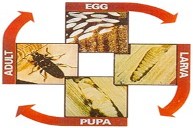| Woodworm Lifecycle |
From Egg to Adult
In order to understand the proper treatment necessary for woodworm, it is important to know about the woodworm lifecycle. In fact woodworms are not really worms, they are wood boring insects in their larval stage. It is when they are in that state that the extensive damage is down to the wood, however, as will now be explained.
 We have treated over 11,000 woodworm cases in the UK. Request a quotation now.
We have treated over 11,000 woodworm cases in the UK. Request a quotation now.
The woodworm lifecycle begins when the female beetle (see “common woodworm types” and “uncommon woodworm types” for more information on the different kinds of beetle) lay their eggs in the crevices of the wood. If there is already a woodworm infestation, then this may well be in the holes that are already present. If it is a fresh piece of wood, then any crack or indentation will do. They do not lay their eggs on the surface because there is no protection for them there.
Once the eggs are laid, the next stage in the woodworm lifecycle begins within a few weeks when they hatch, producing larvae. This is when the damage will be done. The larval stage can last anything from two to five years. The larvae feed on the wood as they tunnel through. They produce frass, or bore dust, which is one of the indications that you have an active infestation of woodworm. This is the time when the structural damage of the wood is caused. As yet, you will notice, there will be no external signs of woodworm damage, no holes have yet been produced. That only occurs when the adult beetle emerges.
Before the adult beetle exits the wood however, it goes through a pupal stage. This is the stage in the woodworm lifecycle when the larvae become adult beetles. This will occur near to the wood’s surface so that the beetle does not have far to go to come out.
Once the adult beetle is fully formed, it chews its way out of the wood, through the small distance necessary to get out. This will occur between May and September. This is when the holes are formed which are visible on the surface. Once out of the wood, the female beetles live no longer than two weeks, and the male beetles only live a few days. This is because the only thing that the adult beetles have to do before they die is mate. The female also lays her eggs before dying, completing the woodworm lifecycle.
It is clear then, that although finding wood boring beetles in your residence is a good indicator that you have woodworm, much damage will almost certainly have been done already. To prevent further damage however, it is important to get in a professional pest controller. Not only will they be able to treat your wood properly to get rid of the woodworm, but they will be able to survey your property to identify the places where you have a woodworm problem. With the use of a borescope they will even be able to determine the existence of woodworm in timber which is not accessible to the eye.
|
| |
|
|
|